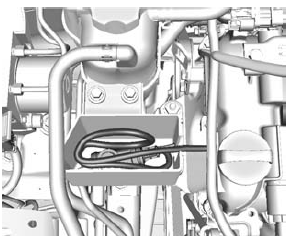Chevrolet Spark Owners Manual: Engine Heater
The engine heater can provide easier starting and better fuel economy during engine warm-up in cold weather conditions at or below -18°C (0°F). Vehicles with an engine heater should be plugged in at least four hours before starting.
- Turn off the engine.

- Open the hood and unwrap the electrical cord. The cord is located in the
passenger side of the engine compartment, near the engine coolant container.
It is shipped from the factory with a tie holding it in place. Use care in removing the tie so that the cord is not damaged.
Check the heater cord for damage. If it is damaged, do not use it. See your dealer for a replacement. Inspect the cord for damage yearly.
- Plug it into a normal, grounded 110-volt AC outlet.
Warning
Improper use of the heater cord or an extension cord can damage the cord and may result in overheating and fire.
- Plug the cord into a three-prong electrical utility receptacle that is protected by a ground fault detection function. An ungrounded outlet could cause an electric shock.
- Use a weatherproof, heavy-duty, 15 amp-rated extension cord
if needed.
Failure to use the recommended extension cord in good operating condition, or using a damaged heater or extension cord, could make it overheat and cause a fire, property damage, electric shock, and injury.
- Do not operate the vehicle with the heater cord permanently attached to the vehicle. Possible heater cord and thermostat damage could occur.
- While in use, do not let the heater cord touch vehicle parts or sharp edges. Never close the hood on the heater cord.
- Before starting the vehicle, unplug the cord, reattach the
cover to the plug, and securely fasten the cord.
Keep the cord away from any moving parts.
- Before starting the engine, be sure to unplug and store the cord as it was
before to keep it away from moving engine parts.
If you do not it could be damaged.
The length of time the heater should remain plugged in depends on several factors. Ask a dealer in the area where you will be parking the vehicle for the best advice on this.
 Starting the Engine
Starting the Engine
Automatic Transmission
Move the shift lever to P (Park) or N (Neutral). The engine will not start in
any other position. To restart the engine when the vehicle is already moving, use
N (Neutral) ...
 Retained Accessory Power (RAP)
Retained Accessory Power (RAP)
These vehicle accessories may be used for up to 10 minutes after the engine is
turned off:
Audio System
Power Windows
The power windows will continue to work for up to 10 minutes or until a ...
Other materials:
Recreational Vehicle Towing
Recreational vehicle towing refers to towing the vehicle behind another vehicle,
such as behind a motor home. The two most common types of recreational vehicle towing
are known as dinghy towing and dolly towing. Dinghy towing is towing the vehicle
with all four wheels on the ground. Dolly towi ...
If a Tire Goes Flat
This vehicle has a tire sealant and compressor kit. See Tire Sealant and Compressor
Kit on page 10-56.
There is no spare tire, no tire changing equipment, and no place to store a tire.
It is unusual for a tire to blow out, especially if the tires are maintained
properly. See Tires on page 10-3 ...
Engine Overheating
The vehicle has an indicator to warn of the engine overheating. See Engine Coolant
Temperature Warning Light on page 5-18.
If the decision is made not to lift the hood when this warning appears, get service
help right away. See Roadside Assistance Program on page 13-5.
If the decision is made ...
